#Recycled Textile Waste Market
Link
The “Recycled Textile Waste Market” research report offers important information about the state of the sector. This research offers in-depth details on the industry’s foundation, productivity, strengths, manufacturers, and current trends that support business expansion and economic strength.
0 notes
Text
#bohostyle#marketing#branding#handmade#quilting#sales#home decor#business#business growth#accounting#rural women crating#rural life#rural women#ruralcore#rural india#rural women artist#recycledmaterials#recycling#reduce reuse recycle#recycled costumes#reducewaste#upcylced#upcycle#textile waste recycling#save environment#avoid fast fashion#slow fashion#clothing recycling#patchwork#kanthawork
2 notes
·
View notes
Text
i've NEVER seen a single good faith discussions about pleather on this website and i want ppl to think critically for one second about the way businesses talk about their products. "vegan leather" is purely a marketing term and nothing else. it was invented by the fashion industry and it has nothing to do with vegans or veganism.
"vegan leather" is basically made of polyester (a type of plastic), but crucially a lot of clothes nowadays are made of polyester either fully or partially because it's cheaper to produce. so of course clothing companies are going to be producing and marketing things that make them more money.
these products are not even targeting vegans, they're making an average customer feel better about their purchases, same way they are now putting "eco" labels on some of their organic cotton clothing. it's just greenwashing. NOTHING in fast fashion is eco friendly in any way - this whole industry is extremely wasteful an exploitative on every level. when are ppl going to realize that these companies just say anything they can to make it seem like they care about anything other than their profit margins. because they don't.
my wish is that ppl that talk about how bad pleather is and how vegans are apparently responsible for all of the microplastic pollution in the world also talked or cared even a little bit about the absolutely horrific abuse and exploitation that happens in the clothing and fast fashion industry. talk about how this industry consistently fails (or outright refuses) to pay its workers a living wage or how they don't provide them humane working conditions - and how that led to thousands of garment workers dying and getting injured when a garment factory collapsed in Bangladesh (and that's not the only tragedy this industry is directly responsible for).
also microplastics are only the tip of the iceberg if you want to talk about the pollution that the clothing industry is responsible for (toxic chemicals and pesticides used in cotton production, garment dyes, the disposal of textile waste etc) - all of which has direct human costs tied to it.
but if your only concern ever was microplastics that clothes can shed then great! avoid all polyester and plastic clothing. but did you know textiles aren't even the primary microplastic contaminants? it's plastic bags, bottles and fishing nets by far. most ppl can't always avoid these plastic items in daily life. but do you eat fish? vegans don't.
i'm just so tired of the pleather discussion focusing on the wrong thing (vegans) when there are so many more aspects about the clothing industry and plastic pollution that never get addressed when they should. and the amount of misinformation on these topics is just laughable at this point. ppl sure enjoy reblogging posts that confirm their biases and free them from having to critically engage with complicated issues because it's so easy to just blame a group of ppl for it.
anyway if you're concerned about ethical clothing (i hope you are) then basically these are your best options:
wear what you already have and don't buy new clothes unless necessary
get second hand clothes
get upcycled clothes
this may seem a bit extreme but these are the only options that don't result in new clothes and textiles being produced because there is an overproduction issue in the clothing industry which is why over 80% of clothes end up in landfills. obviously these options aren't viable for everyone all the time but if the goal is sustainability then that's just the reality of things for now.
you can also do things like mend your clothes so they last longer, learn to sew to make your own clothes etc all of that is better than buying new clothes. donating clothes to a thrift store is also not ideal since they get so many donations that a lot of it ends up in a landfill anyway and recycling clothes is also not straightforward or even possible in a lot of cases. so not buying new/more clothes is the most environmentally friendly option. and before you go no ethical consumption under capitalism blah blah yeah we know. doesn't mean you are powerless and have no choices in anything ever.
please learn more about microplastics, the clothing/textile industry and veganism before you uncritically reblog another misinformed post about "vegan leather" or microplastics. also please don't uncritically believe what i wrote here either. if you're seriously interested in these topics then your source for this information shouldn't be some tumblr post in the first place. there are lot of studies, documentaries and articles about all the things i mentioned. i'm not a researcher or a scientist, so don't ask me. i'm just tired.
#vegan leather#veganism#pleather#fast fashion#long post#not interested in discussion tbh#i'm just venting#do ppl that are obsessed with pleather even read clothing labels#do you know where your clothes were made#do you know who made them#and do you know how much they were paid for their labor?#why aren't you mad about that
223 notes
·
View notes
Note
Hi! What was the podcast on fabric sustainability that you've been listening to? Thanks!
OKAY it's called Weaving Voices, it's a 10-episode fixed run podcast series and 1000% worth listening to.
I will say, I went in expecting - like I listen to a lot of textile podcasts, ok, and there's often a formula of like. Soft-spoken (white) female host, guest is soft-spoken (white) female speaking gently about how she has disengaged personally from society/destructive textile systems and now owns four chickens and designs knitting patterns or weaves little jackets for rescue donkeys or whatever. (Which: I have criticisms of because they're lovely and soft to listen to but create the veneer and feeling of like. I can opt out and personally be sustainable even if the planet is burning, and while that feels very nice to listen to, your small scale chicken farm will do nothing without you engaging with the rest of society and advocating for changes that will prevent the planet from burning.)
(Which: I would encourage you to consider reading Homeward Bound by Emily Matchar, which touches on the concept of the homesteading movement as creating the illusion of being able to opt out from society and is an interesting critical lens.)
BUT ANYWAY the first episode of Weaving Voices is actually not about fiber at all, it's an interview with a guy talking about how we have to dismantle modern economics or society will crumble, so you have to kind of know that going in.
However. It is a very, very good podcast, and rather than just focusing on tackling the problems with our current fast fashion model it really digs into solutions, which is refreshing. The other thing I love is that it talks about system-wide solutions and reform, rather than "here's a pair of pants you, the listener, can buy to personally solve textile sustainability." It treats the responsibility for this as collective which I don't often see, and examines in more detail things like:
the politics of the current 'fabric sustainability' grading system and why they're inexplicably biased towards plastic fibers
rebutting some of the anti-sustainability arguments against genuinely sustainable textiles like silk and alpaca
examining the fallacy of "donating clothes" in a fast-fashion world where so many of the RTW garments are meant to be disposable, and speaks to people working in textile markets in Ghana where bales of waste clothing from the western world are shipped, for some reason
and then quite relatedly a really good examination of how the three R's are reduce/reuse/recycle but we've focused so hard on recycling that we've forgotten the other two, and why that's uhh not ideal
microplastics!! in everything!! and there's a super cool interview with a scientist tracking how microplastics move into soil and water systems as a consequence of laundering plastic clothes
also there are some profoundly moving episodes speaking to indigenous textile producers that are examining, effectively, what pre-industrial textile systems looked like as both a lens to consider the impact of colonization on these systems and also how different current textile production and consumption has become.
a really moving episode on the garment worker labour movement in LA and how they're advocating for national legislation after being successful on a state scale (!!!)
It's really special and cool, and what I find is that like. The episodes themselves were interesting, but what I'm really loving is that the more I let the series marinate, the more thoughts I have and the more I realize I've learned. It educates in an indirect way but did a really good job.
#listen and then you too can be angry about microplastic life cycles and also feel defensive on behalf of silk!#also if i had known that all i needed to do was say send me asks#and people would send me asks#i love getting asks so much just don't be weird about it or demand that i produce a fic out of my butt at 8pm on a wednesday#anyway i can talk about textiles for days i love fibre arts so much#this is my happy place#fibre arts are the best arts#textile sustainability tag
55 notes
·
View notes
Text
Green Living Made Easy: Eco Shopping Tips
Live a Greener Life: Sustainable Shopping and Living Tips with Brandfinity
Brandfinity, a leading branding and marketing agency in India, is committed to promoting eco-conscious practices. In line with this mission, we present these valuable tips to help you make sustainable choices in your everyday shopping and living:
Embrace Sustainable Materials for Clothing and Home Goods:
Opt for eco-friendly options: Look for clothing and home goods made from organic cotton, hemp, or bamboo. These materials often require less water and fewer chemicals compared to conventional options.
Reduce waste, support circularity: Choose products made from recycled or upcycled materials. This not only minimizes waste but also promotes a circular economy where resources are reused.
Support Local and Organic Produce:
Reduce your carbon footprint: Opt for locally grown fruits and vegetables. This not only supports local farmers but also reduces the environmental impact of transportation.
Prioritize health and a healthy planet: Choose organic produce to avoid harmful pesticides and synthetic fertilizers that can negatively affect your health and the environment. Organic farming practices promote soil health, biodiversity, and water conservation.
Minimize Waste with Reusable Bags and Containers:
Ditch the plastic: Invest in reusable shopping bags made from durable materials like canvas or recycled materials. This eliminates the need for single-use plastic bags, significantly reducing waste.
Embrace reusables for bulk items: Utilize reusable containers when buying bulk items like grains, nuts, and spices. This eliminates the need for single-use packaging, further minimizing waste. Remember to wash and sanitize your reusable bags and containers regularly.
Champion Eco-Friendly Brands and Products:
Look for certifications: Support brands and products with certifications that showcase their environmental commitment, such as organic, fair trade, or cruelty-free labels. These certifications ensure adherence to specific standards and minimal harm to the environment and workers.
Sustainable practices matter: Choose brands that prioritize sustainability throughout their supply chain, from sourcing materials to manufacturing and packaging. By supporting these brands, you encourage more sustainable business practices with your purchasing power.
Embrace Sustainable Fashion with Second-Hand and Thrift Shopping:
Reduce demand, extend lifespans: Consider second-hand and thrift stores for unique and stylish clothing at affordable prices. This reduces the demand for new clothing production and gives pre-loved items a second chance.
Promote a circular fashion economy: By choosing second-hand fashion, you contribute to a circular economy by extending the lifespan of clothing and minimizing textile waste. Don't forget to donate or sell your own unwanted clothing to keep the cycle going!
Live a greener life, one sustainable choice at a time!
Partner with Brandfinity to craft an eco-conscious brand identity and marketing strategy that resonates with your sustainability goals. Visit us at https://brandfinity.ch/en/ to learn more.
#business#wix#logo design#ui ux design#cms development services#marketing#web developer#website#e commerce#education
3 notes
·
View notes
Text

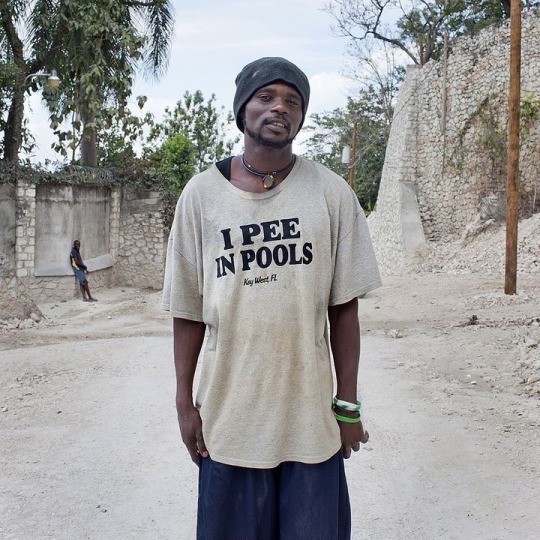


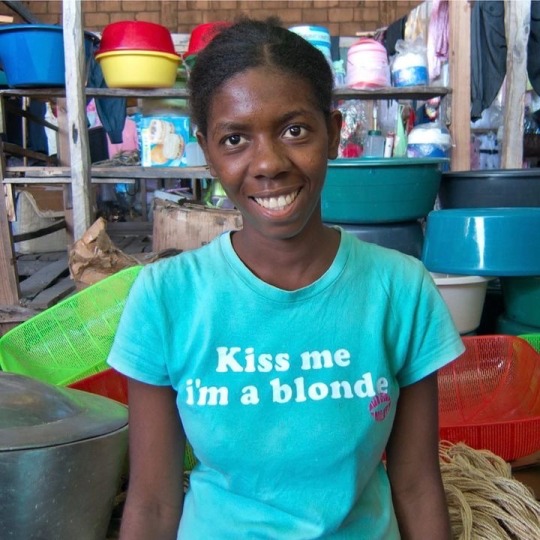
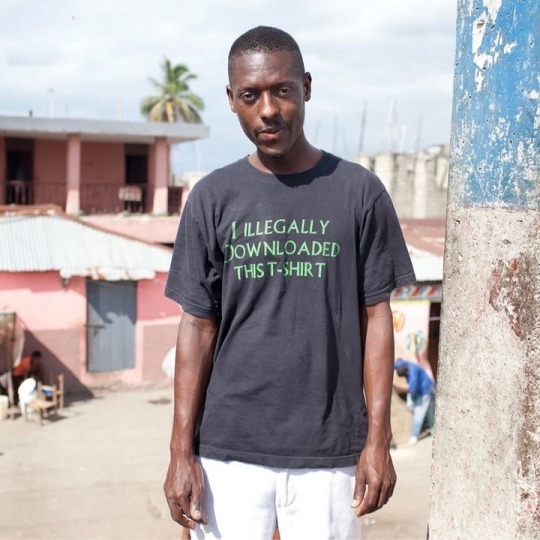

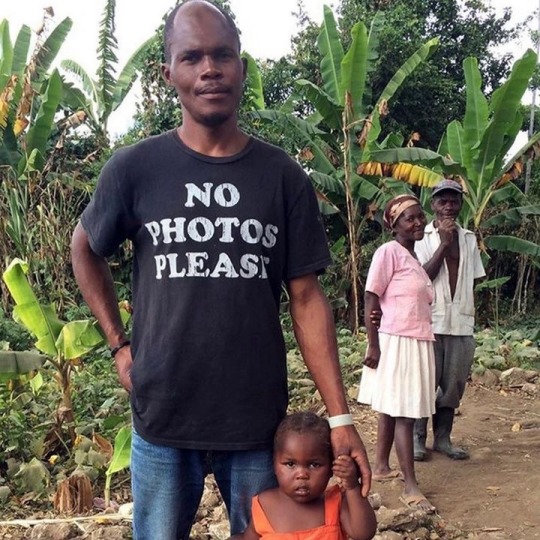

artneversleeps Haitian Villagers Photographed Wearing Donated “Slogan' Tees from America by Paolo Woods
The fashion industry produces 92 million tons of discarded fabric each year. We’re able to grasp a rough understanding of a t-shirt's life cycle, from manufacturer to landfill.
While the majority of textile waste fails to encounter a preceding owner, few rays of hope glisten in second-hand shops and complex recycling processes. Often successful, chains like Value Village manage to breathe new life into pre-loved items, selling cheap, accessible alternatives to brand-new goods. This method is effective, but far from perfect, prompting international agreements akin to Haiti's very own 'Pèpè' trade. In the city of Port au Prince, the country's waterfront capital, lies a market known as 'Croix-des-Bossales'. A place that houses millions of pounds of America's most outrageous, unwanted clothing.
Here, it's nearly impossible to stumble across anything purchased outside of the Western world, constantly importing undesirable graphics that just simply didn't sell.
Arriving in massive bails, the garments are often sold for less than a dime, which in an impoverished market, allows local citizens to wear quality clothing at a cheap price. On the surface, this idea appears as a great small-scale solution for our global textile crisis, but has ultimately created some larger economic issues.
As the markets become saturated, tailors are forced out of business, and more ironically, the majority of these items are being produced in Haiti's local sweatshops prior toexport. On top of that, those wearing the clothes are unaware of each slogan, speaking Creole as a native dillect.
Words by @archivethreads
Soundtrack: Europe Is Lost by Kae Tempest @wetwicksdry

#Paolo Woods#Wearing#Photographed#12/2022#Villagers#Haitian#fashion#qotd#quoteoftheday#tshirt#Tshirt humor#dirty humor#political#photo journalism#x-heesy#fucking favorite#now playing#music and art#contemporaryart#archivethreads#kae tempest#black is beautiful
46 notes
·
View notes
Photo
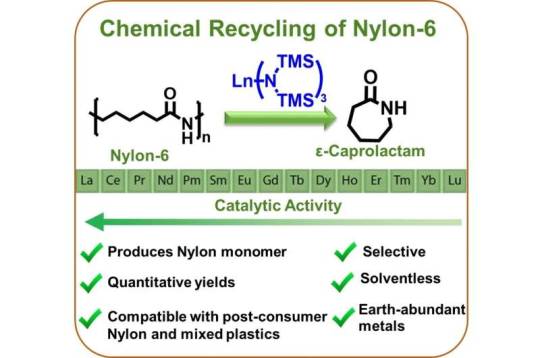
A new method to recycle Nylon-6 by unlinking polymer chains
Nylon-6 is a tough, non-biodegradable plastic that cannot be recycled by conventional methods. A new way has now been introduced by a team from the U.S. in the journal Angewandte Chemie International Edition.
With an easily accessible lanthanum trisamido catalyst, Nylon-6 can be depolymerized highly selectively, nearly quantitatively, with no solvent, and at moderate temperatures to recover the monomer, ε-caprolactam. The monomers are removed sequentially from one polymer end, just like unthreading pearls from a chain.
Nylon is the fabric from which stockings are made. It is also the material of choice for many applications in areas including automobile manufacturing, packaging, infrastructure, textiles, and fishing. Its advantageous properties, such as elasticity, chemical resistance, high tensile strength, and high abrasion resistance get in the way of its biodegradability. Abandoned nylon fishing nets, for example, account for about 10% of the plastic waste in the oceans.
Industrially, the variant Nylon-6 is made through a ring-opening polymerization of ε-caprolactam on a scale of 5 million tons a year. The market volume is projected to reach 21.5 billion dollars by 2026. The heaps of trash are growing correspondingly, increasing the danger to the environment and our health. In addition, the production of Nylon-6 has a large CO2 footprint.
Read more.
22 notes
·
View notes
Text
Unsold clothing may no longer be destroyed in Europe

More than 100,000 tons of discarded clothing ends up in a desert in Chile
Europe is putting a stop to the throw-away culture through a ban on destruction[1] and a digital product passport with information about shelf life and repairability. No more mass destruction of clothing and other unsold merchandise.[2]
Every second in Europe, a full garbage truck of clothing is burned or dumped[3]. And every year, an estimated 11 to 32 million unsold and returned garments are destroyed. Europe has been wanting to reduce this gigantic waste for some time. The European Member States and the European Parliament reached an agreement to this end on Monday evening 4-12: Ecodesign for Sustainable Products Regulation[4]. The aim of the 'eco design law' is to make many products more repairable, reusable and recyclable. A product passport and a ban on destruction of unused goods are the key measures.
1. What is a digital product passport?
Consumers are already somewhat familiar with this: the energy label on refrigerators and washing machines gives an indication of their sustainability. That label (or product passport) has had an enormous impact on making those appliances more energy efficient.
The European Parliament and the EU member states now have an agreement to roll out the digital passport more widely and to deepen its content. First of all, almost all products on the European market will have to have such a passport: from car tires and steel to washing tablets and cosmetics to clothing or smartphones. The only exceptions are food, medicine, cars and weapon systems, for which there are separate regulations.
In addition to any energy consumption, the passport also contains information about the origin, composition, repair and disassembly options of the product. This should also make it easier to repair and recycle them. “People can know at a glance which product is the most durable or easiest to repair,” said MEP Sara Matthieu (Green), who was rapporteur in the negotiations.
2. What does the ban on destruction mean?
Initially, the ban applies to textiles. Globally, 92 million tons of textile waste are produced annually. A large portion of these are returned or unsold goods. In two years' time, they may no longer be destroyed, but must be reused or recycled. This ban will eventually be extended to electronics and electrical appliances. Massive quantities of these are also destroyed every year, especially cheaper items that are not sold or have been returned to the manufacturer.
The new rule goes hand in hand with stricter requirements for composition, repairability and disassembly of goods. The details will be worked out product by product by the European administration, but some guiding principles are a ban on adhesives, the absence of toxic substances, the obligation to have spare parts available and, above all, to offer them at an affordable price. The passport should eventually lead to a 'repair score', comparable to the energy label.
Matthieu (Green) expects a huge impact on the consumer market. 'Instead of offering disposable products for mass consumption, companies will offer many more services through robust devices. So to speak, you will no longer buy a washing machine, but an number of wash cycles.'
3. How comprehensive are the measures?
That depends on the control. The product passport is also an important instrument for this. Europe is counting on the famous 'Brussels effect': foreign producers will have to adapt their products if they want to maintain access to the gigantic European consumer market. Although the European consumer organisation BEUC[5] warns against loopholes. The organisation mainly sees a risk that international online platforms such as Amazon or Alibaba will circumvent the new law.
4. Is this agreement now final?
It has already rounded the most important cape. The agreement was finalised in the so-called trialogue negotiations between the European Parliament, the European Council and the Commission. Now it must be approved by Parliament and the Member States, but that counts as a formality.
Source
Lieven Sioen, Onverkochte kledij mag niet meer vernietigd worden in Europa, in: De Standaard, 6-12-2023, https://www.standaard.be/cnt/dmf20231205_96579697#:~:text=In%20eerste%20instantie%20is%20het,ze%20hergebruikt%20of%20gerecycleerd%20worden.
[1] Deal on new EU rules to make sustainable products the norm; https://www.europarl.europa.eu/news/en/press-room/20231204IPR15634/deal-on-new-eu-rules-to-make-sustainable-products-the-norm
[2] Read also: https://www.tumblr.com/earaercircular/722179599996534784/towards-a-circular-and-more-sustainable-fashion?source=share
[3] Read also: https://www.tumblr.com/earaercircular/723895455727157248/new-report-clothes-are-mercilessly-downcycled-or?source=share & https://www.tumblr.com/earaercircular/720260226679488512/hms-answer-about-the-dumped-clothes-article?source=share
[4] The proposal for a new Ecodesign for Sustainable Products Regulation (ESPR), published on 30 March 2022, is the cornerstone of the Commission’s approach to more environmentally sustainable and circular products. The proposal builds on the existing Ecodesign Directive, which currently only covers energy-related products. https://commission.europa.eu/energy-climate-change-environment/standards-tools-and-labels/products-labelling-rules-and-requirements/sustainable-products/ecodesign-sustainable-products-regulation_en
[5] The European Consumer Organisation (BEUC, from the French name Bureau Européen des Unions de Consommateurs, "European Bureau of Consumers' Unions") is an umbrella consumers' group, founded in 1962. Based in Brussels, Belgium, it brings together 45 European consumer organisations from 32 countries (EU, EEA and applicant countries). BEUC represents its members and defends the interests of consumers in the decision process of the Institutions of the European Union, acting as the "consumer voice in Europe". BEUC does not deal with consumers’ complaints as it is the role of its national member organisations.
3 notes
·
View notes
Text
It can often feel like you need a PhD in material science just to understand the textiles that appear on garment care labels. While natural fibres including wool and cotton are pretty easy to identify, synthetics such as polyester and viscose can be harder to decode.
Generally speaking, human-made materials fall into one of two categories: those derived from fossil fuels and those derived from chemically processed cellulose (the building block of plants).
Fossil fuel-based fibres
Polyester
Polyester is the most common fibre on the planet, making up over half of the overall fibre market. It is a type of plastic called polyethylene terephthalate or PET which is moulded into yarn then woven into a fabric.
Dr Georgia McCorkill, a fashion lecturer at RMIT, says fossil fuels are the basis of the chemicals that make PET, so from an environmental and sustainability standpoint, their origins are already problematic. Since plastic does not so much biodegrade as split into smaller and smaller pieces (it was only invented last century, so we can’t really know how long it will hang around), polyester is also problematic when it is washed, as it can shed microplastics into waterways and at the end of a garment’s life.
“In an ideal world [polyester] would exist in a closed-loop system where it would be perpetually melted down and reformed into new fabrics,” says McCorkill. “However the design, production and waste recovery systems required to make this a reality don’t exist.”
Recently, there has been a push towards recycled polyester – which uses plastic bottles as an input – instead of virgin resources. While recycled polyester has a lower carbon footprint than conventional polyester, it is not a perfect solution. Turning plastic bottles into new plastic bottles is more efficient than recycling them into polyester, and it can be done on a loop. Current methods for turning plastic into polyester at scale do not result in a material that can be recycled again post-use.
McCorkill says polyester is an extremely strong material and can be necessary in activewear, sportswear or outdoor gear. But, she says, “polyester can get very smelly over time and become unwearable”. This is because it clings to odour and stains, making them impossible to remove.
Nylon
Like polyester, nylon is also a plastic derived from fossil fuels but it is more expensive to make and therefore used less frequently. It makes up about 11% of the clothing fibre market. Since nylon is stretchier and stronger than polyester, it is often found in swimwear and yoga gear.
Manufacturing nylon releases nitrous oxide into the atmosphere, contributing to global heating, and because nylon is a plastic it won’t biodegrade. The founder of Cloth & Co, Caroline Poiner, suggests looking for recycled alternatives such as Econyl that are made with recovered waste products, including fishing lines and other waste pulled from the ocean.
Unlike recycled polyester, recycled nylon can be regenerated into new nylon more than once, provided it has not been blended with other fibre types.
Elastane
The other fossil fuel-based fibre you’ll often encounter on a garment care label is elastane (also called spandex or Lycra). It is commonly blended with other fibres to provide added stretch (it can expand and recover up to five times its own length).
This elasticity makes it similar to rubber. But while natural rubber or elastic is derived from trees, elastane is derived from polyurethane and will not biodegrade. While elastane’s capacity for stretch and recovery makes it very useful in athletic gear and underwear, when exposed to heat or too much strain, its elasticity will degrade over time.
Man-made cellulosic fibres
Viscose rayon is the umbrella term for fibres manufactured from cellulose, but as many fibres fall into this broad category, it can be very confusing. The list includes rayon, viscose, modal, lyocell, acetate, bamboo and cupro. Aside from cupro, which is made from cotton waste, all of these materials are derived from wood pulp.
Poiner warns that although bamboo and the like are often marketed on their eco credentials, it can be “comparable to synthetic fibres in its impact on the environment and also the health and wellbeing of workers."
Sourcing viscose rayon has historically been linked to deforestation, and even now the environmental not-for-profit Canopy estimates that of the 200m trees cut down each year to make viscose, at least half come from ancient or endangered forests. If you want to be sure these fabrics have been sustainably sourced, look for FSC or PEFC certifications.
The process of turning wood or cotton waste into a fabric “requires highly toxic chemicals in its production”, says Poiner, who notes some manufacturers choose factory sites where they can avoid strict health and safety regulations.
Less harmful cellulose fabrics are manufactured using a closed-loop system, that recovers and reuses toxic solvents. EcoVero and Tencel are types of lyocell, trademarked by fabric giant Lenzing, which are made using best practice pulp-sourcing and chemical management during the production process.
There are also exciting innovations in this space, with new types of viscose rayon made using agricultural, food or clothing waste as a source material instead of trees, however these are not yet widely available.
7 notes
·
View notes
Text

Unlimited life of clothes: “We reincarnate”
If you could choose between quality, sustainability, price tag, or style when buying clothes, what is your priority?
There is a noticeable smell upon entering the underground area of Brick Lane Vintage Market. This is a smell that is characterised by the secondhand clothes hanging all around scattered stalls. Some retro, some classics, some winter jackets and sweaters, and even season-less needs with striking visuals and various colours mixed together. Each hanger rack has a variety of models and colours. Everyone must be prepared to put their hand in to see the clothes one by one because there could be "treasures" that cannot be found with one "screening".
"We don't call it secondhand clothes anymore. It is now called pre-loved or vintage fashion, including upcycled, recycled clothes pieces.”
His grey hair shows that he may not be young anymore. Still, Andy, who has been working in one of the Brick Lane vintage stalls for five years, has a keen eye for detail and the conditions of items that are still good enough or not on display in the collection. He refuses to use the words secondhand clothes. For him, these reincarnated clothes have their own value. This value can be better reflected by calling them pre-loved or vintage. The clothes supplied to the store come in dozens of boxes and kilos. Behind the cashier's desk is a non-permanent room in a corner that was purposely made as a warehouse for unsorted clothes. That afternoon, Andy was seen busy sorting several black suits and giving them price tags. When asked where he got all the clothes from, he answered firmly,
"That's my boss's secret. He has a good connection with people who are also pre-loved and vintage clothes suppliers. I won't let you know where it is coming from.”


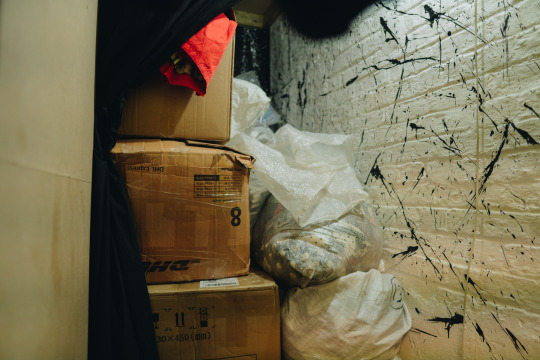
Even though Andy does not openly tell where the clothes come from, it is common knowledge that pre-loved clothes are indeed sold per kilo or even per ton and are imported from other parts of the world, leaving lots of carbon footprints along the distribution process. According to the EU Strategy for Sustainable and Circular Textiles1, 1.4 million tons of textile waste were exported to non-EU countries in 2020. Yet, there is still no reliable overview data on these flows, whether they were pre-sorted or not, and their ultimate destinations.
Shop owners and employees like Andy sort and curate the kilograms of clothes received. He gives prices based on the cost of clothes in the market. Some of the clothes in his shop are priced at $300 and up because they are well-known brands, classic, aged, and well-maintained. Other clothes have prices below or the same as market prices. Everything is calculated based on the clothes’ condition, whether the clothes are fixed or upcycled already or in raw condition. Raw, which means it is not curated, not upcycled, and comes with unrepaired damage, the cheaper it gets.


Unlike the shop where Andy works, Shiley (known as @the_vintage_reborn_london on Instagram) is another shop owner who directly looks after her own shop. Her interest in fashion and antique collections can be seen in her knowledge of fashion history and her ability to curate items. Unlike most sellers on Brick Lane, Shirley gives prices according to her expertise in determining the value of an item. For her, the things she has made have their own soul and might be the only ones that can’t be found elsewhere. This makes many pre-loved clothes pretty fantastic because apart from being more environmentally friendly, they also have unique tastes for some customers.
How sustainable are pre-loved clothes?
As you read through this article, it means, directly or indirectly, you are one of those people who are concerned about whether or not the choice of clothes you buy are sustainable. Let's take a brief look at what impact this actually has on our fashion choices. Referring to the journal on Waste Management in the Fashion and Textile Industry, which was just released in 20222. Until now, the fashion and textile industry is the second largest polluter in the world, following the oil industry2.
Most people and scientists nowadays refer to the term carbon footprint. This means our sins can be easily calculated. The carbon footprint calculation is also counted not only for the manufacturing process but also for the process of distributing until the waste processing these clothes. Our purchasing behaviours contribute to 39 million tons of post-consumer fashion waste created globally every year, primarily in the form of clothes. More than 57% of all apparel thrown away ends up in landfill. The textile water waste used in garment production is untreated and contains toxic substances such as, mercury, arsenic, lead, and others which are directly dumped into the water bodies risking the human race and aqua life around the globe2.

Calculating the carbon footprints of each process needs detailed data on the ingredients that are being used during the process. There are 3 types of ingredients in forming our clothes: plant-based, synthetics, and animal-based clothes. Although all three have an impact on the environment, synthetics and animal-based have the most significant percentage of impacts. For example, overgrazing of grasslands via sheep and cashmere goats raised for their wool, and each time “synthetic” garments are washed (polyester/nylon), around 1900 single microfibers are freed into the marine ecosystem, creating their way into the oceans2. Does all this data make us pessimistic about wearing clothes? Is it time we all migrated into a sect of naked sun worshipers?
Sustainability aims to derive maximum advantage from products by increasing their lifespan. Sustainability practices try to do as good as possible by trying to reduce the production process. According to Nadira Lase, "Most of us don't count the reuse carbon footprint because it's a different category as it doesn't make new clothes anymore. After all the calculations we did, what determines whether the product has a significant carbon footprint or not is in the material, not in the use of transportation. As the results of our calculation of the life cycle assessment (LCA), transportation does not produce a lot of carbon compared to the manufacturing process, that's why reuse is more favourable than the others." Nadhira Lase4 works as an Environmental Specialist at an LCA software company based in the Netherlands. She assesses and calculates the carbon footprint and LCA in fashion, including in the manufacturing process and the distribution of all until it wastes calculation.
However, carrying out sustainable fashion practices is still challenging to do thoroughly. Many considerations must be made regarding quality, price, style, and sustainability practices. Knowing that sustainable fashion can not only partially be defined as how big the carbon footprint is in certain clothes. One of the students attending the University of the Arts London, Vallerie7, who is a regular customer of clothes at thrift or vintage stores stated, “For me, fashion is a statement, I feel that thrifting helps me explore myself through it because it has a lot of choices and it is also a way for me to define myself”. But even so, she also revealed how difficult it is to always purchase pre-loved clothes, especially in London. Most of the clothes sold at curated vintage markets have fantastic prices for students and part-time workers like them. Some clothes that have a lower price are sold in a not curated condition often at times they are not very good quality.

“In the end, for my daily needs, some of it I bought at Primark again because the prices are lower. The need to save money and lower prices make it hard to be more sustainable. The existing system still forces me to return to this fast-fashion cycle.” Some of you reading this article may agree with Vallerie, or maybe not.
What can we do?
Price is still becoming a primary concern for most consumers in making decisions rather than sustainability. They know they care about the environment, but they don't act in a sustainable manner when buying products. It will take time and a small step for sustainability and zero waste lifestyle to be a pillar in the fashion industry rather than just another trend. Therefore, it is urgent to change the mindset of the ethical apparel industry.
The fashion design industry is worth $2.4 trillion, employing about 60 million people worldwide, and the size of the business is expected to continue to grow in the coming years2. It is time for fashion designers, corporations, and the government to create joint actions for a "close loop" fashion system. Efforts in research, knowledge sharing, and strengthening synergies will lead to changes in fashion trends and help countries develop the need for ethical fashion. Many brands and companies have also started to shift to more sustainable ways of manufacturing their products. The more sustainable scheme available on the market, the more choices consumers have in buying things to be more sustainable. Step by step, it will raise behaviour change in the consumers as well as all the market stakeholders.
Although not to mention, there is a lot of debate over sustainable fashion, pros and cons around those big brands that have launched organic and sustainable collections. Their transparency, not only over the source of material but also fair labour often being questioned. The term "greenwashing" also needs attention, as customers don't want to get blinded and trapped in an unconscious fashion choice. All those significant steps from those powerful and big brands companies must still be accompanied by the efforts of consumers who have the same important role in making decisions. Being fully aware and sustainability-conscious people is something that we can do to provoke a system change.

The most promising strategy is reduction aimed at avoiding waste generation. Textile waste management includes a 3R approach; Reduce, Reuse, Recycle. In a literal sense, "reduce" is still the most preferred method to reduce textile waste effectively. According to an annual report by climate NGO WRAP3 an additional 9 months of active use to extend the life of your garment will reduce your carbon footprint, waste and water footprint by approximately 20-30%. This may require physical expertise to repair a product and our mental strength to restrain our ego rather than buying something we don't need. Both are hard, indeed. Practice is required to make this become a new habit. The second one is “reusing”. This is where thrifting or why buying pre-loved clothes could be an answer for this. As there is no emission for the production process, reusing clothes leaves less carbon footprint and is considered a wise choice in practising a sustainable lifestyle. There are a lot of start-ups and organisations that make a business model like this. For example, Nuw (www.thenuwardrobe.com) is a social network platform for sharing clothes with people in the local community. A charity shop such as Oxfam also became the first national charity to develop its own facility for recycling and reusing clothes and never sends clothes to landfills. Quoted from an interview with Forbes, Stella Tennant, a model for an Oxfam photoshoot, stated, "One dress could raise enough money to provide a woman in Bangladesh with a safe bathing cubicle, a shirt could provide safe, clean water for 10 people in an emergency, and a coat could help train two farmers in Rwanda to better cope with extreme weather conditions." Vintage markets and thrift stores are indeed the closest business model that runs the reusing practice. The last one is “recycling”. Recycling approaches are more cost-effective than waste disposal, and due to the high energy, water, and manufacturing consumption, recycling is much better than making new textiles. Economically wise, recycling also generates job openings for many small businesses. The term reworked or upcycled clothes is often found in many vintage markets. These clothes are re-produced by small and medium enterprise businesses using clothing materials that are no longer used to become value-added goods with the same quality as new clothes.
Ultimately, no matter how hard this article scientifically suggests you support preloved fashion stores, suggest you buy clothes at a charity shop, or consider organic or sustainable fashion brands, everything goes back to your decision. The best choice that we can make also depends on our circumstances. We can try at least to be environmentally conscious, which will drive us to be as sustainable as possible in every given situation.
So, if you could choose between quality, sustainability, price tag, and style when choosing your clothes, which is your priority?
References:
Boiten, V. (2022). Building a circular economy for textiles supported by common rules on Extended Producer Responsibility (EPR) in the EU. Recommendations and open questions for the upcoming revision of the EU Waste Framework Directive (WFD), 16. https://emf.thirdlight.com/link/51d055xl9pwf-jbvkcd/@/preview/1?o
Gupta, R., Kushwaha, A., Dave, D., & Mahanta, N. R. (2022). Waste management in fashion and textile industry: Recent advances and trends, life-cycle assessment, and circular economy. Emerging Trends to Approaching Zero Waste, 215-242.
WRAP. (2012). Valuing Our Clothes: The Cost of UK Fashion, 5. https://wrap.org.uk/sites/default/files/2021-01/WRAP-valuing-our-clothes-2012-07-11.pdf
7 notes
·
View notes
Text
4 Reasons Why Sustainable Fashion Matters
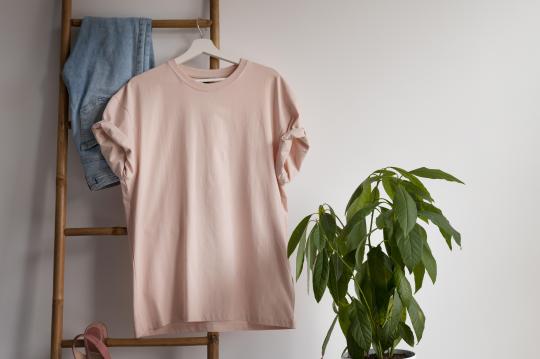
Implementing sustainable fashion industry practices is a growing concern as assessed by the UN’s COP26 summit. We still have a long way to curb environmental encroachment in the name of unsustainable fashion practices.
Thankfully, given the growing awareness, many people are becoming conscious about sustainable practices in the fashion industry and why these are a top priority.
Popularize eco-friendly fashion
As eco-friendly fashion becomes the primary alternative, slow fashion is gaining precedence. Slow fashion allows more designs to reach the market and become exclusively available. The pre-order process ensures sustainable resources are used to produce high-quality pieces.
Businesses normalize sustainable clothing production and sourcing methods as diverse eco-friendly fashion becomes the norm.
Reduce poaching
Unfortunately, poaching is still very much in play across the globe. Besides the legally slaughtered animals, there is a threat to exotic and near-extinct wildlife due to the fashion industry.
Close to extinction species like the Sumatran Tiger, American Alligator, and many others still suffer from poaching activities. The dwindling numbers of these animals is a wake-up call for the fashion aficionados, who need to take notice and raise their voice against this cruelty.
Rather than validating original leather, fur, and wool, it is much more beneficial for the fauna to transition to human-made fibers, including bamboo plant fibers, recycled materials, and other viable alternatives.
Subsequent waste reduction
As sustainable clothing brands gain prominence, so is the upward trend in waste reduction. It’s no secret that sustainable textile manufacturing units rely on eco-friendly, recycled resources to do their bidding.
As sustainable clothing lasts longer due to a lack of chemical processing and lasting fibers, you must buy less. Resultantly, the number of clothes produced and trashed every year will also reduce.
Reduce environmental harm
Fast fashion has left the planet high-and-dry with a massive carbon footprint. Solid landfill, water consumption, toxic waste, pesticides, and insecticides used from unsustainable fiber production- all of it contribute to planetary harm.
These practices are also harmful to the workers’ health and well-being in these industries. Sustainable fashion is synonymous with fair trade and humanely safe industrial practices.
Promote fair trade
The fast fashion industry can mass-produce and keep prices low. All this is possible, since most of the workforce is based in third-world countries, with cheap labor availability. Child labor, which is illegal and cheap in developing nations, is synonymous with fast fashion.
Sustainable fashion clothing
By consuming sustainable clothing, you help organic fashion brands stay in business. In turn, they can employ workers in safe and healthy working conditions. Sustainable brands are also certified ethical and do not employ children.
#sustainable fashion#sustainable fabrics#sustainable clothing#clothing manufacturers#clothing manufacturers in india
2 notes
·
View notes
Text
Levulinic Acid Market Size Estimated to Reach USD 67.8 million, Expanding at a CAGR of 5.2% by 2031
The global levulinic acid market is estimated to flourish at a CAGR of 5.2% from 2023 to 2031. Transparency Market Research projects that the overall sales revenue for levulinic acid is estimated to reach US$ 67.8 million by the end of 2031. Levulinic acid's potential to fit into circular economy models, promoting recycling and minimizing waste, emerges as a unique driver. Companies exploring closed-loop processes enhance sustainability and appeal to environmentally conscious consumers.
Increasing collaborations between the levulinic acid industry and other sectors, such as textiles and packaging, create novel applications. These partnerships foster cross-industry innovations, expanding the reach of levulinic acid into unexplored markets. The customization of levulinic acid solutions for specific needs in emerging markets becomes instrumental. Tailored formulations for local industries cater to unique challenges, fostering adoption in regions with evolving industrial landscapes.
Download Sample PDF of the Report: https://www.transparencymarketresearch.com/sample/sample.php?flag=S&rep_id=6260
Market Segmentation
By Service Type:
Production Services
Research and Development Services
Custom Synthesis Services
By Sourcing Type:
Biomass-Derived Levulinic Acid
Petrochemical-Derived Levulinic Acid
By Application:
Pharmaceuticals
Agriculture
Biofuels
Food Additives
Personal Care Products
Others
By Industry Vertical:
Chemical Industry
Food and Beverage Industry
Pharmaceutical Industry
Cosmetics Industry
Agricultural Industry
By Region:
North America
Europe
Asia-Pacific
Latin America
Middle East and Africa
Regional Analysis
North America: Leading the market due to strong demand for bio-based products and significant investments in green chemistry research.
Europe: Showing substantial growth driven by stringent environmental regulations and the presence of major market players focused on sustainable chemicals.
Asia-Pacific: Expected to witness the highest growth rate owing to increasing industrialization, growing awareness of bio-based products, and supportive government policies.
Latin America and Middle East & Africa: Gradual market growth with increasing investments in renewable chemicals and emerging applications in agriculture and pharmaceuticals.
Market Drivers and Challenges
Drivers:
Environmental Regulations: Stringent environmental policies promoting the use of renewable chemicals.
Sustainability Trends: Growing consumer preference for eco-friendly products.
Technological Advancements: Innovations in production technologies reducing costs and improving efficiency.
Diversified Applications: Expanding use in pharmaceuticals, agriculture, and biofuels driving demand.
Challenges:
High Production Costs: Biomass-derived levulinic acid production is cost-intensive compared to petrochemical methods.
Market Penetration: Limited awareness and adoption in certain regions.
Supply Chain Issues: Fluctuations in biomass supply affecting production stability.
Market Trends
Bio-based Product Development: Increased focus on developing bio-based alternatives for various applications.
Collaborations and Partnerships: Companies forming strategic alliances to enhance production capabilities and market reach.
Research and Innovation: Continuous R&D activities to improve production processes and discover new applications.
Government Support: Policies and subsidies promoting the use of renewable chemicals.
Future Outlook
The levulinic acid market is poised for robust growth over the next decade. With ongoing technological advancements and increasing investment in sustainable chemistry, the market is expected to expand its applications further, especially in high-growth areas like biofuels and bioplastics. Additionally, as industries continue to transition towards greener alternatives, levulinic acid will play a critical role in shaping the future of renewable chemicals.
Key Market Study Points
Comprehensive analysis of market dynamics including drivers, challenges, and opportunities.
Detailed segmentation and regional analysis to identify high-growth areas.
Assessment of competitive landscape and key players' strategies.
Insights into recent developments and technological advancements.
Forecast of market trends and future outlook.
Competitive Landscape
The competitive landscape of the levulinic acid market includes key players such as GF Biochemicals, Avantium, Biofine Technology LLC, and Segetis. These companies are focusing on expanding their production capacities, strategic collaborations, and investing in research and development to enhance their market position.
Buy this Premium Research Report: https://www.transparencymarketresearch.com/checkout.php?rep_id=6260<ype=S
Recent Developments
GF Biochemicals: Expansion of production facilities to meet the growing demand for levulinic acid.
Avantium: Introduction of innovative bio-based products and strengthening market presence through strategic partnerships.
Biofine Technology LLC: Advancements in production technologies to reduce costs and improve efficiency.
Segetis: Development of new applications for levulinic acid in personal care and food industries.
About Transparency Market Research
Transparency Market Research, a global market research company registered at Wilmington, Delaware, United States, provides custom research and consulting services. Our exclusive blend of quantitative forecasting and trends analysis provides forward-looking insights for thousands of decision makers. Our experienced team of Analysts, Researchers, and Consultants use proprietary data sources and various tools & techniques to gather and analyses information.
Our data repository is continuously updated and revised by a team of research experts, so that it always reflects the latest trends and information. With a broad research and analysis capability, Transparency Market Research employs rigorous primary and secondary research techniques in developing distinctive data sets and research material for business reports.
Contact:
Transparency Market Research Inc.
CORPORATE HEADQUARTER DOWNTOWN,
1000 N. West Street,
Suite 1200, Wilmington, Delaware 19801 USA
Tel: +1-518-618-1030
USA – Canada Toll Free: 866-552-3453
Website: https://www.transparencymarketresearch.com
0 notes
Text
#marketing#handmade#bohostyle#branding#quilting#sales#home decor#business#business growth#accounting#reduce reuse recycle#recycled costumes#recycledmaterials#recycling#upcycle#ecofriendly#reuse#save environment#avoid fast fashion#reducewaste#reduce textile waste#recreate#eco friendly#sustainable fashion#slow fashion#reduce textile pollution#upcycling fashion
2 notes
·
View notes
Text
Exploring the Role of Research and Development in Indian Spun Polyester Yarn Industry
In recent years, the Indian textile industry has seen a remarkable transformation, particularly in the domain of spun polyester yarn. As a vital segment of this industry, spun polyester yarn producers in India have increasingly relied on research and development (R&D) to stay competitive and meet global standards. This blog explores how R&D is driving innovation and growth in the Indian spun polyester yarn sector.
The Importance of R&D in the Spun Polyester Yarn Industry
The Indian spun polyester yarn industry, characterized by its vast and diverse landscape, has become a focal point for textile innovation. Research and development play a critical role in enhancing the quality and performance of spun polyester yarn. By investing in R&D, producers can develop new types of yarns, improve existing products, and streamline manufacturing processes.
Advancements in Technical Yarns in Polyester
One of the most significant areas where R&D has made a considerable impact is in the development of technical yarns in polyester. These yarns are engineered to meet specific performance criteria, making them ideal for various specialized applications, including automotive textiles, medical textiles, and high-performance sportswear.
For instance, companies like SD Polytech have been at the forefront of creating innovative technical yarns in polyester. Their R&D efforts focus on enhancing the durability, elasticity, and thermal resistance of their yarns, which has opened up new markets and applications. Technical yarns in polyester are now being used in more demanding environments, proving the importance of continuous R&D in maintaining industry relevance.
Innovations by Spun Polyester Yarn Producers in India
Several Indian producers have made significant strides in the spun polyester yarn industry through dedicated R&D efforts. These companies understand that innovation is key to staying competitive in both domestic and international markets.
1. Enhanced Fiber Quality: By leveraging advanced technologies and conducting extensive research, producers have improved the quality of polyester fibers. This includes developing fibers that are finer, stronger, and more uniform, which translates to better yarn quality.
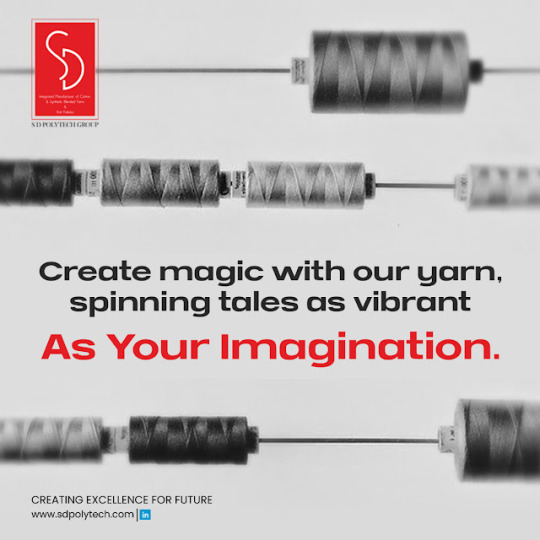
2. Eco-friendly Production: R&D has also enabled spun polyester yarn producers in India to adopt more sustainable practices. Innovations such as recycling polyester waste and using environmentally friendly dyes and chemicals are now becoming standard practices, reducing the ecological footprint of the industry.
3. Cost-Effective Manufacturing: Through research, producers have optimized their manufacturing processes, reducing costs and increasing efficiency. This has made Indian spun polyester yarn more competitive on the global stage, attracting buyers looking for high-quality, cost-effective yarn.
The Role of SD Polytech in R&D
SD Polytech stands out as a leading example of how R&D can transform the spun polyester yarn industry. With a robust R&D department, SD Polytech focuses on developing cutting-edge products that meet the evolving needs of the market. Their research includes exploring new polymer blends, enhancing fiber properties, and improving dyeing techniques to produce vibrant, long-lasting colors.
SD Polytech commitment to R&D has also led to the creation of specialized yarns for technical applications. Their innovations have not only enhanced product performance but have also expanded the potential uses for polyester yarn, reinforcing the company’s position as an industry leader.
Future Prospects
The future of the spun polyester yarn producers in India looks promising, largely due to the ongoing efforts in R&D. As producers continue to invest in research, we can expect further advancements in yarn quality, sustainability, and application diversity. Technical yarns in polyester will likely see increased demand as their superior properties make them suitable for more specialized and high-performance uses.
Conclusion
Research and development are the cornerstones of innovation in the Indian spun polyester yarn industry. By focusing on improving fiber quality, adopting eco-friendly practices, and enhancing manufacturing efficiency, spun polyester yarn producers in India are well-positioned to compete globally. Companies like SD Polytech exemplify the transformative power of R&D, leading the charge in creating high-performance technical yarns in polyester. As the industry continues to evolve, R&D will remain crucial in driving growth and maintaining India’s competitive edge in the global textile market.
Also Read:
Cotton Yarn Export Market: Opportunities and Challenges for Delhi's Manufacturers
Global Perspectives: Delhi's Yarn Manufacturers in the International Market
Originally published at https://sdpolytech.blogspot.com
0 notes
Photo
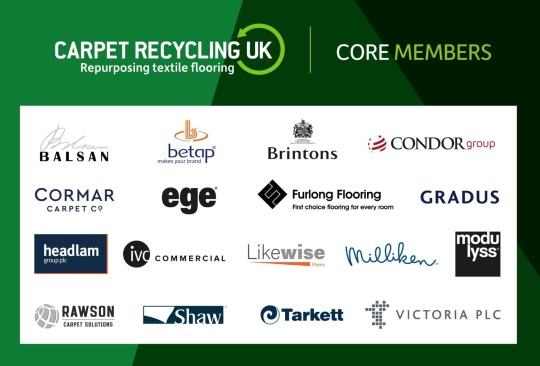
Carpet Recycling UK Annual Conference, Dinner and Awards 10-11 July 2024

Collaboration and networking across the flooring sectors
Registration has opened for Carpet Recycling UK’s (CRUK) eagerly-awaited Annual Conference, at the voco® St. John’s Solihull on July 10th and 11th 2024 where collaboration across the flooring sector will be the main focus.
With a booking deadline of June 28, CRUK’s two-day event offers its members and wider network dissemination and networking opportunities for UK, EU and international decision makers from across the supply chain.
Representing 85% of the UK market, through their 138-strong membership, 17 key manufacturers and distributors and extensive UK-wide and international outreach, CRUK is helping the sector on its sustainability journey to reduce and recycle textile flooring waste while developing opportunities to create circularity within the sector through a more design for recycling-led approach.
The comprehensive programme will cover important updates on legislation and policy affecting the sector within the UK, EU and US plus updates on technology and research projects and EPR structures. Other topics to be explored include how collaboration across the wider flooring sector can help the sector advance to become more efficient and effective when it comes to the management of waste and sustainability.
A panel of industry experts and invited keynote speakers will deliver insightful presentations and discussions throughout the event. This year the conference will also provide sponsorship opportunities for organisations to highlight and promote their brand’s eco-friendly credentials and demonstrate their commitment to sustainability within the wider sector. Additionally, there will be a dedicated exhibitor area for companies to showcase their innovative products and services.
The evening event will allow for greater networking and collaboration opportunities, a relaxed evening meal followed by the popular Carpet Recycling UK annual awards. The awards have been developed to recognise and reward companies and organisations who are taking voluntary and proactive action to demonstrate and drive sustainability in the carpet and textile flooring sector. The categories are Reuse/Recycling Project of the Year, Most Sustainable Product of the Year, Circular Economy Initiative of the Year and for the first time are open to members and non-members. To register for the conference and awards please visit the links below.
Adnan Zeb-Khan, CRUK Scheme Manager comments: “Our comprehensive two-day conference programme will explore the important issues affecting the sector today and possible future developments and changes. Our range of expert speakers have been carefully selected and identified to provide you with the most up-to-date knowledge and information, making it a must-attend event.
“We are looking forward to welcoming lots of familiar and new faces at our 2024 Conference where we can network and identify opportunities and see what others in the wider flooring sector are having to deal with helping us to become better prepared in the future.”
CRUK’s 17 core members are Balsan, Betap, Brintons Carpets, Condor Group, Cormar Carpets, ege Carpets, Furlong Flooring, Gradus, Headlam Group, IVC Commercial, Likewise Floors, Milliken, Modulyss, Rawson Carpet Solutions, Shaw, Tarkett and Victoria Group. They are taking voluntary producer responsibility for the products they place on the market and striving to reduce waste in production as well as for their customers, helping to create cost savings.
For more information, including details about the 2024 Conference and Awards event, email: [email protected] or visit www.carpetrecyclinguk.com and go to the events section.
0 notes
Text
Eco-Friendly Options: How Wholesale Bath Towels Suppliers Are Going Green

Introduction
As global awareness of environmental issues continues to rise, industries across the board are seeking ways to reduce their ecological footprint. The textile industry, known for its significant environmental impact, is no exception. Wholesale bath towels suppliers are increasingly adopting eco-friendly practices to meet the growing demand for sustainable products. By integrating organic materials, reducing chemical use, and improving manufacturing processes, these suppliers are making substantial strides toward greener operations.
Organic and Sustainable Materials
One of the primary ways wholesale bath towels suppliers are going green is through the use of organic and sustainable materials. Traditional cotton farming is notorious for its heavy use of pesticides and water. In contrast, organic cotton is grown without synthetic chemicals, making it a much more environmentally friendly option. Additionally, some suppliers are exploring alternative fibers such as bamboo, which grows quickly and requires fewer resources than conventional cotton. These materials not only reduce environmental impact but also offer consumers a healthier and more natural product.
Eco-Friendly Manufacturing Processes
Beyond the materials used, the manufacturing processes employed by wholesale bath towels suppliers are critical to their overall environmental impact. Eco-friendly suppliers are investing in technologies and practices that minimize waste, reduce water usage, and lower carbon emissions. For example, some manufacturers utilize closed-loop systems that recycle water and chemicals, significantly reducing their water footprint. Others have switched to renewable energy sources, such as solar or wind power, to run their operations. By adopting these green manufacturing techniques, suppliers are reducing their ecological footprint and promoting a more sustainable industry.
Certifications and Standards
To assure customers of their commitment to sustainability, many wholesale bath towels suppliers are seeking certifications from recognized environmental organizations. Certifications such as Global Organic Textile Standard (GOTS), OEKO-TEX Standard 100, and Fair Trade provide third-party verification that the products meet stringent environmental and social criteria. These certifications help consumers make informed choices and encourage suppliers to maintain high standards of sustainability in their production processes.
Consumer Demand Driving Change
The shift towards eco-friendly options in the wholesale bath towels market is largely driven by consumer demand. As more people become aware of the environmental and health impacts of their purchasing decisions, they are increasingly seeking out sustainable products. This demand is prompting suppliers to innovate and prioritize eco-friendly practices to stay competitive. By choosing to support green suppliers, consumers are playing a crucial role in driving the industry towards more sustainable practices.
The Future of Sustainable Towels
Looking ahead, the trend towards sustainability in the wholesale bath towels sector is likely to continue growing. Advances in technology and increased investment in research and development will further enhance the efficiency and environmental friendliness of towel production. Additionally, as regulatory pressures increase and more businesses commit to corporate social responsibility, eco-friendly practices will become the standard rather than the exception. Wholesale bath towels suppliers who embrace this green revolution will not only contribute to a healthier planet but also meet the evolving expectations of their customers.
In conclusion, the movement towards eco-friendly options among wholesale bath towels suppliers represents a significant positive shift in the textile industry. By focusing on organic materials, sustainable manufacturing processes, and obtaining certifications, these suppliers are leading the way in creating a more sustainable future. This green transformation, driven by consumer demand and technological advancements, promises to benefit both the environment and the economy.
0 notes